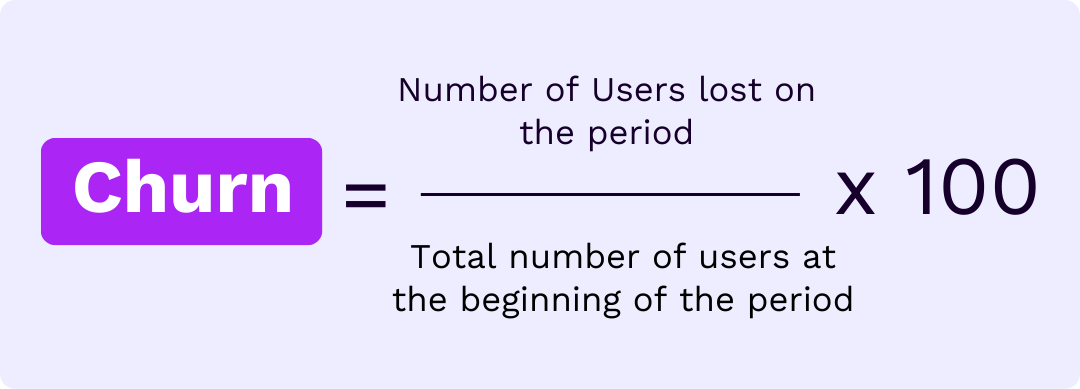Churn Rate: Understanding, Analyzing, and Optimizing
Introduction
Churn rate is a key indicator in mobile marketing that measures the proportion of users or customers lost over a given period. Closely monitored by marketing specialists and product teams, it helps assess user loyalty, optimize retention strategies, and improve overall acquisition campaign performance.
A high churn rate may indicate poor product-market fit, low customer satisfaction, or intense market competition. By understanding and mastering this metric, businesses can adapt their strategies to maximize retention and extend user lifetime value.
What Is Churn Rate? How Is It Calculated?
Definition of Churn Rate
Churn rate, also known as “attrition rate,” represents the percentage of users or customers who stop using a product or service over a defined period.
It refers to the loss of customers or users over time. It applies to various contexts, including SaaS subscriptions, mobile applications, online services, and loyalty programs.
Calculation Formula
It is calculated as follows:

For example, if a mobile app starts the month with 10,000 active users and loses 2,000 during this period, the monthly rate would be:
(2000/10000)×100=20%
Measurement Periods
Churn can be measured over different periods:
- Daily: Suitable for high-frequency usage apps (e.g., social media, mobile games).
- Weekly: Useful for services with moderate usage frequency.
- Monthly or Annually: More relevant for subscription-based services and SaaS platforms.
Why Is it an Essential Indicator in Mobile Marketing?
Churn rate plays a central role in analyzing a mobile app’s performance and impacts several strategic aspects:
Impact on Lifetime Value (LTV)
A high rate reduces the user lifespan and, consequently, their value to the company. A high LTV indicates that users stay longer and generate more revenue.
Customer Retention Evaluation
Churn is a key indicator of an app’s ability to retain users. High retention suggests that users find value in the app. Conversely, low retention can signal poor user experience, excessive complexity in a mobile game, or a mismatch between the product and the target audience.
Assessing Product-Market Fit
A high churn rate may indicate a misalignment between the product and market expectations. Early-stage loss of customer / user often means the app is not meeting user needs.
Optimizing Acquisition Costs
High churn means acquisition efforts and investments are not being fully leveraged. Improving retention enhances return on investment (ROI) for marketing campaigns.
Types of Churn Rates
There are multiple types of rates depending on the analysis context, each serving a specific purpose.
Customer Attrition Rate
When to Use It?
- To evaluate customer loyalty for a subscription-based service (e.g., Netflix, Spotify, SaaS).
- To measure the effectiveness of a loyalty strategy.
User Attrition Rate
When to Use It?
- For mobile applications to analyze how many users uninstall the app or stop engaging.
- To assess the effectiveness of onboarding and retention campaigns.
Transactional Attrition Rate
When to Use It?
- In e-commerce or services with in-app purchases to identify users who stop buying.
- To adjust promotional strategies and loyalty programs.
Voluntary vs. Involuntary Churn
- Voluntary Churn: When a user actively decides to leave (e.g., canceling a subscription). Analyzing this can reveal areas for product or service improvements.
- Involuntary Churn: When churn occurs due to technical issues (e.g., expired credit cards, bugs). Addressing this can prevent unnecessary losses. Implementing personalized communication strategies can help re-engage users.
What Is a Good Churn Rate?
The ideal churn rate depends on the industry and business model:
- Mobile Apps: A churn rate below 20% over 30 days is considered good.
- SaaS and Subscriptions: A monthly churn rate below 5% is acceptable.
- E-commerce: A customer retention rate of 30% to 40% is a solid target.
Key Insights Gained From Churn Rate Analysis
Analyzing churn helps to:
- Identify reasons users leave: Through feedback, behavioral analysis, and satisfaction surveys.
- Segment users by behavior: Distinguishing loyal users from those who churn quickly allows for tailored retention strategies.
- Determine critical dropout moments: Pinpointing when users disengage enables corrective actions (e.g., improving onboarding, optimizing communication).
- Refine marketing and product strategies: Testing different approaches like promotional offers, exclusive content, or loyalty programs to enhance retention.
- Optimize user acquisition: A high churn rate on a particular channel may indicate that users acquired through it are not well-qualified.
Best Practices to Reduce Churn Rate
Optimize Onboarding
An effective onboarding process improves retention from day one by helping users understand the app’s value.
Enhance User Experience
A smooth and intuitive interface reduces frustration and encourages continued use.
Personalize Engagement
Push notifications and emails should be relevant and tailored to user preferences.
Analyze User Feedback
Collecting and analyzing reviews and surveys helps identify friction points.
Implement Loyalty Programs
Rewards, subscriptions, and exclusive content encourage users to stay engaged.
Key Concepts Related to Churn Rate
- Retention Rate: The counterpart to churn rate, measuring the percentage of active users over a given period.
- Lifetime Value (LTV): The total financial value a user brings to the company throughout their lifecycle.
- Cohort Analysis: Examines user behavior based on acquisition date.
- Net Promoter Score (NPS): A measure of user satisfaction and loyalty.

Do not hesitate to contact with our teams
Addict can support you to improve your performance.
Conclusion
Churn rate is a critical indicator for any mobile marketing strategy. When tracked and analyzed accurately, it helps optimize user experience, improve retention, and increase the profitability of acquisition campaigns.


